Tailless Whip Scorpion Profile
The tailless whip scorpion may look like the stuff of nightmares, but its appearance belies the fact that it is relatively harmless to humans, having neither a stinger nor venomous jaws.
The tailless whip scorpion often called ‘whip spiders’ resemble a cross between a crab, spider and a scorpion, but despite their name, they are are not a scorpion.
They are an amblypygid (pronounced ‘Am-bly-pi-jid), an ancient order of arachnid, which means ‘blunt tail’ – referring to the insects’ lack of a flagellum, or tail, seen on insects, such as the scorpion.
They inhabit hot, tropical and subtropical areas in several parts of the world; including the Americas, parts of Africa and Asia.
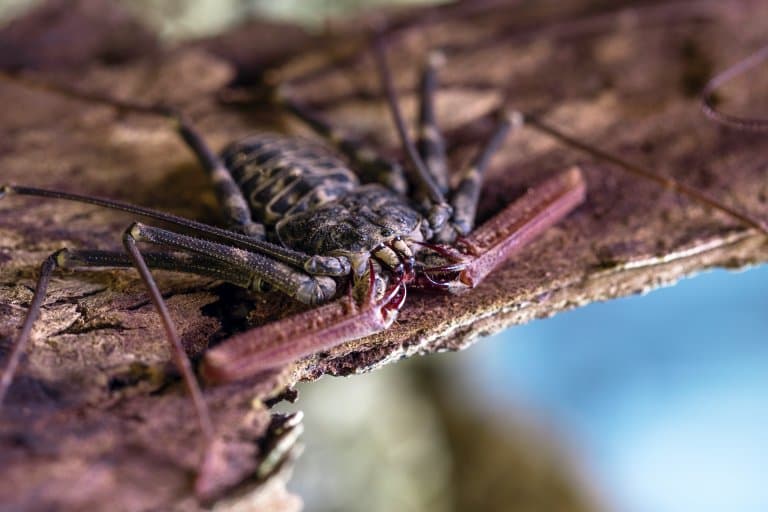
Tailless Whip Scorpion Facts Overview
| Habitat: | Forests, dense vegetation or other dark, quiet places (eg caves), hiding under rocks, plants or bark until dark |
| Location: | Tropical and subtropical regions of North and South America, Asia, Africa |
| Lifespan: | 5-10 years |
| Size: | 5-68cms (2-27 inches) |
| Weight: | Up to 1g |
| Color: | Ranging from mottled black and brown, sometimes pale brown or even cream patches |
| Diet: | Frogs, large insects, crustaceans, small vertebrates such as lizards or even small birds |
| Predators: | Bats, lizards or birds |
| Top Speed: | Unknown |
| No. of Species: |
155+ |
| Conservation Status: |
Least concern |
There are 5 recognized families of tailless whip scorpion, with 17 genera and over 155 species. They should not be confused with their close relative the true whip scorpion also known as the vinegaroon, that have a whiplike tail, and are in a different taxonomy order entirely.
Their size and coloring can vary depending on species, but body features remain the same and they range between 5cms and a rather giant 2-feet in legspan.
The body of the creature is flat, which helps them to hide under tree bark and in small spaces. They possess 8 long legs, but the front two legs are not used for walking, instead having the purpose of sensory organs. These two front legs sense vibrations and help with orientation. They are used to explore and understand its surroundings; travel and move about; and sense and catch prey.
The whip-like movement of these sensory legs are what earned the tailless whip scorpion the name of ‘whip’ scorpion or ‘whip’ spider. Their pincer-like front arms – pedipalps – have large barbs on them which they use for grasping and tearing apart their prey.
Tailless whip scorpions are nocturnal and reclusive creatures, hiding in small, dark spaces until night falls and they come out to hunt.
They are a predatory insect that feast on other insects and small prey. They have also been known to eat small vertebrates, such as frogs, lizards and even small birds.
Since the tailless whip scorpion lacks venom glands, they must rely on crushing their prey as they cannot immobilise it with poison. They sense their prey with their whip-like front legs, before seizing it and crushing it with their vicious, spiked pincers and tearing it apart with their robust jaws.
Despite their fearsome appearance, they are actually quite timid creatures and will quickly shy away from any perceived danger. The fact that they are non-venomous can also account for their reclusive and timorous habits, since they do not have many weapons to defend themselves against attack.
Interesting Tailless Whip Scorpion Facts
1. The tailless whip scorpion is not a scorpion
Despite its name, the tailless whip scorpion is not actually a scorpion, or a spider. It resembles a cross between the two.
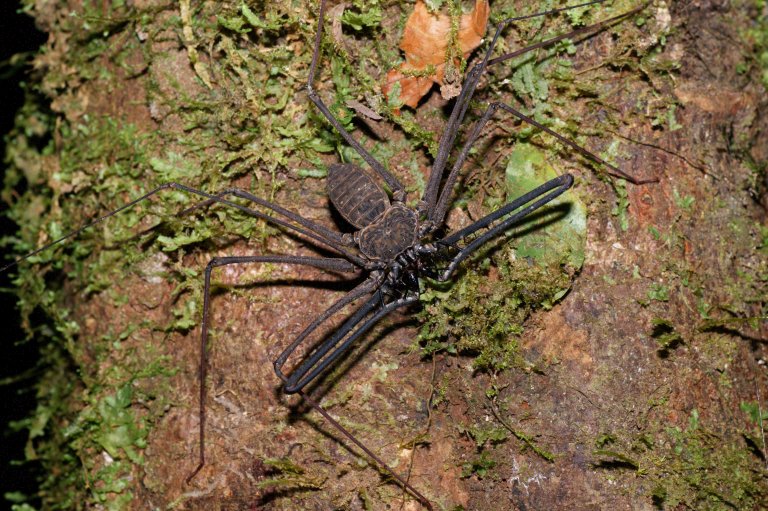
2. Amblypygids have been on the earth for many years
Fossil remains have indicated that variations of the tailless whip scorpion have been around since as many as 415 million years ago (the Devonian Period).
There are relatively few remaining species today. 1
3. They often travel sideways like crabs
This allows their front legs to sense their surroundings through vibrations.
4. Although arachnids, tailless whip scorpions do not spin webs
They do not have a spinneret or silk glands and therefore do not have the ability to create webs like spiders.

5. They can make chirping sounds
This noise comes from rubbing their front legs together.
6. The tailless whip scorpion is almost completely blind
They may have eight eyes, but they have very poor eyesight, and rely heavily on the sensors in their two front legs (not used for walking), which they use for navigation and catching their prey.
It turns out eyes on that important if you hunt at night and can feel the vibrations of prey!
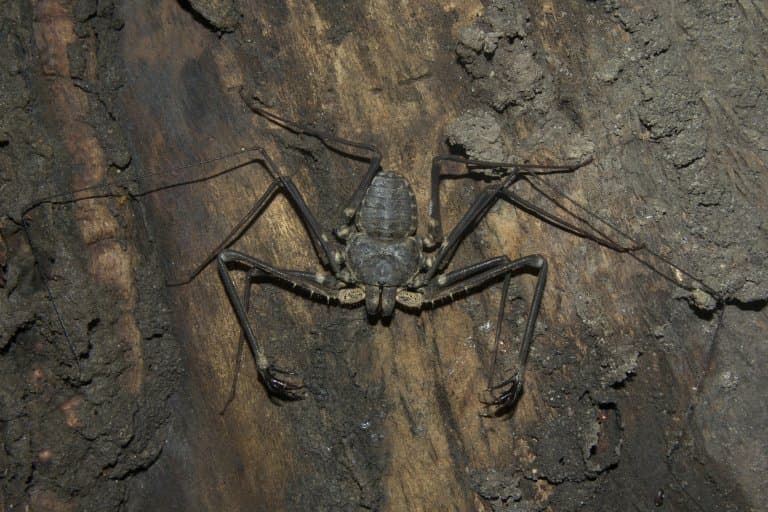
7. The male of the species will fasten their front pedipalps together during mating
This is to prevent the female from killing and eating the male when mating is finished.
The female tailless whip scorpion are usually bigger than the males and they can be just as aggressive towards other members of the species.2
8. Tailless whip scorpions will fight to the death over territory
During a study, scientists observed the territorial behaviour of the tailless whip scorpion, noting that they were aggressive seemingly with no distinction between the age or sex of their opponent.
The matching of the fighting pairs would depend on the size of the other’s pedipalps – so a creature smaller in body with large front pincers would match to larger opponents simply because of their claw size. With evenly matched pairs, the fight would continue until one opponent fled, or was killed and eaten.
9. Some species of Amblypygids have the ability to socially interact through their sensory front legs
This is extremely uncommon in arachnids, but in some species of the tailless whip scorpion it has been observed that the mother can interact through this means with her offspring and vice versa.
10. They use their sensory front legs as homing devices
During a scientific study, it was noted that some species of the tailless whip scorpion were able to travel up to 45 metres from their home base, and still find their way home after hunting.
This is unusual – especially given the dense, littered vegetation that they often inhabit, with multiple obstacles blocking their route home.
11. The tailless whip scorpion may go for over a month without food
This is because amblypygids generally do not feed before, during, and after molting, which they will do several times during their lives.
They will hang upside down from a surface so gravity helps their old exoskeleton fall from their body.
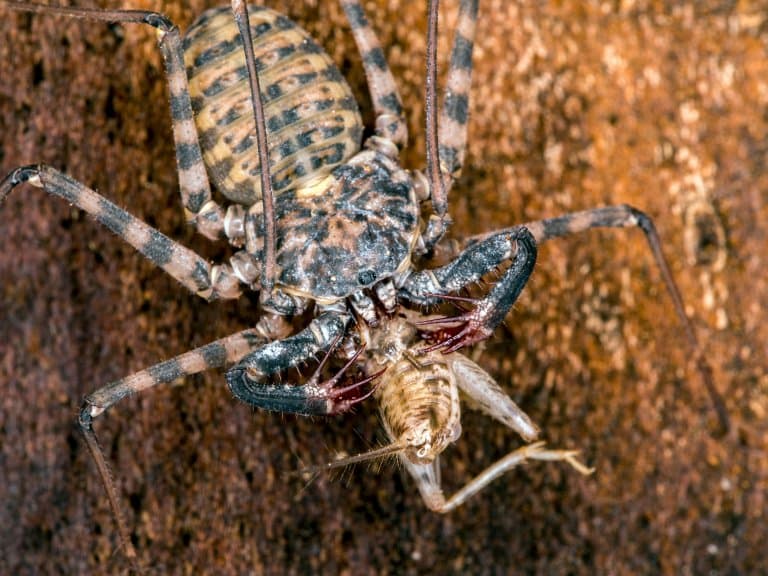
12. The mother carries her eggs underneath her belly until hatching
Once the infant tailless whip scorpions hatch, they climb onto the mother’s back, and will stay there for up to a week until they are able to fend for themselves.
Any babies that cannot remain on the mother’s back, or can’t fend for themselves after this initial period will not survive.
13. One was observed feeding on an Antillean crested hummingbird
A tailless whipscorpion species called ‘Phrynus longipes‘ in the British Virgin Islands was the first amblypygid ever to have been witnessed preying on a bird before.
Their body is around 3 inches in length, but their front legs have been recorded growing up to 10 inches.3

14. Tailless whip scorpions have made some media appearances
They have been featured on TV shows such as the Fear Factor, and, most notably, the Mexican tailless whip scorpion appeared in the feature film Harry Potter and the Goblet of Fire.
15. They are often kept as pets
A number of species of tailless whip scorpion are sold as pets, which can be kept in a heated enclosure, will live for 5-10 years and can be fed small insects, such as crickets.
Some of the most popular species sold as pets include – Damon diadema, Damon medius, Damon variegatus, Euphrynichus amanica, Heterophrynus batesii, Acanthophrynus coronatus, Phrynus marginemaculatus and Paraphrynus mexicanus.
16. They are not a whip scorpion!
Thelyphonida is an arachnid order known as whip scorpions or vinegaroons, which are different to the tailless whip scorpion. While similar in appearance, a close relative and also quite terrifying – vinegaroons have a whiplike tail, and they discharge a vinegar-smelling acid when hunting!
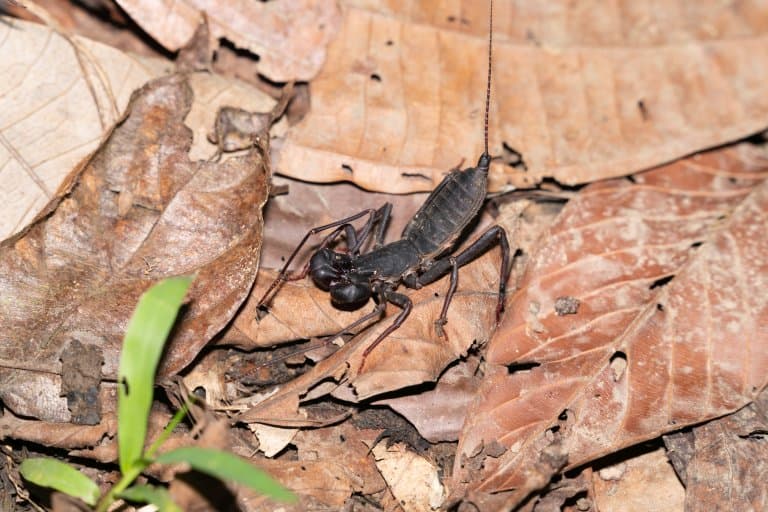
Tailless Whip Scorpion Fact-File Summary
Scientific Classification
| Kingdom: | Animalia |
| Phylum: | Arthropoda |
| Subphylum: | Chelicerata |
| Class: | Arachnida |
| Order: | Amblypygi |
| Families: | Palaeoamblypygi
Euamblypygi
|
Fact Sources & References
- Russell J. Garwood (2017), “The phylogeny of fossil whip spiders“, BMC Evolutionary Biology.
- “Tailless Whip-Scorpion“, USDA Forest Service.
- Jennifer L. Owen, James C. Cokendolpher (2006), “Tailless Whipscorpion (Phrynus longipes) Feeds on Antillean Crested Hummingbird (Orthorhyncus cristatus)“, The Wilson Journal of Ornithology.
